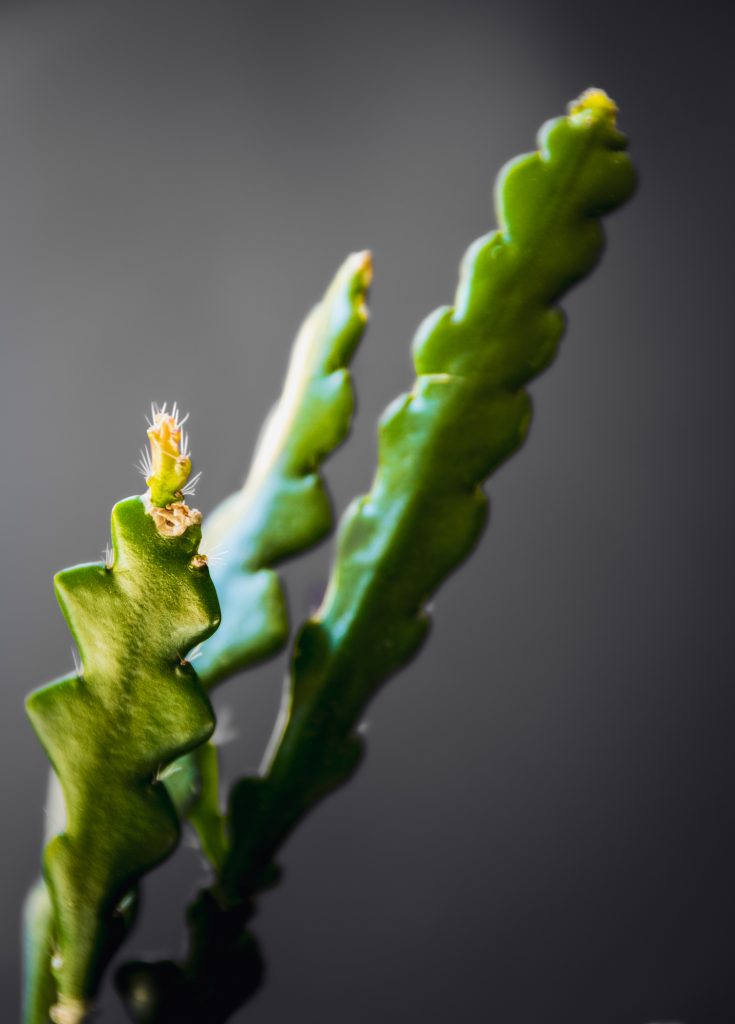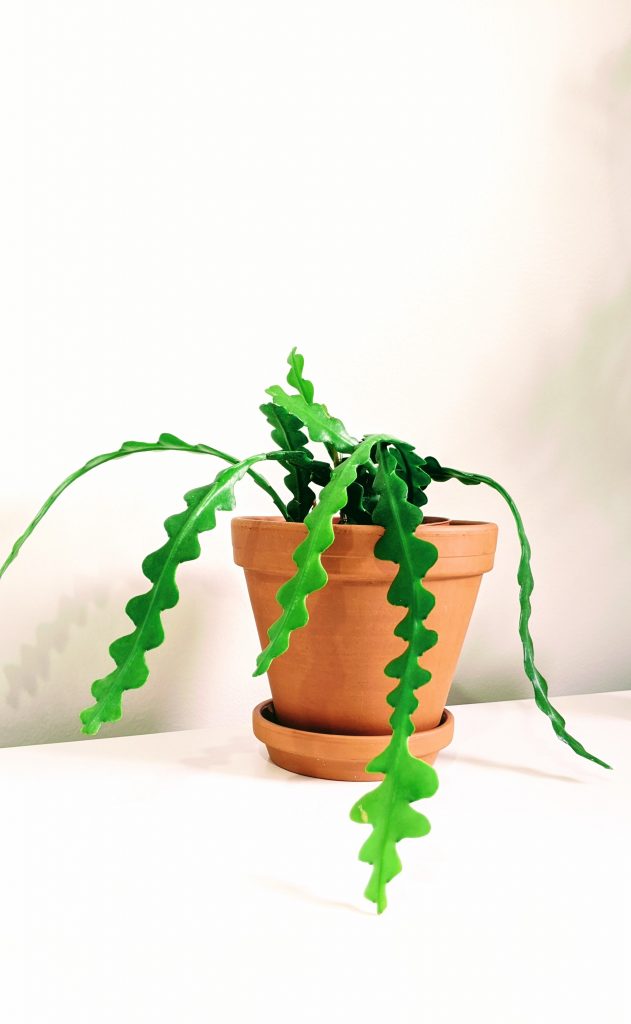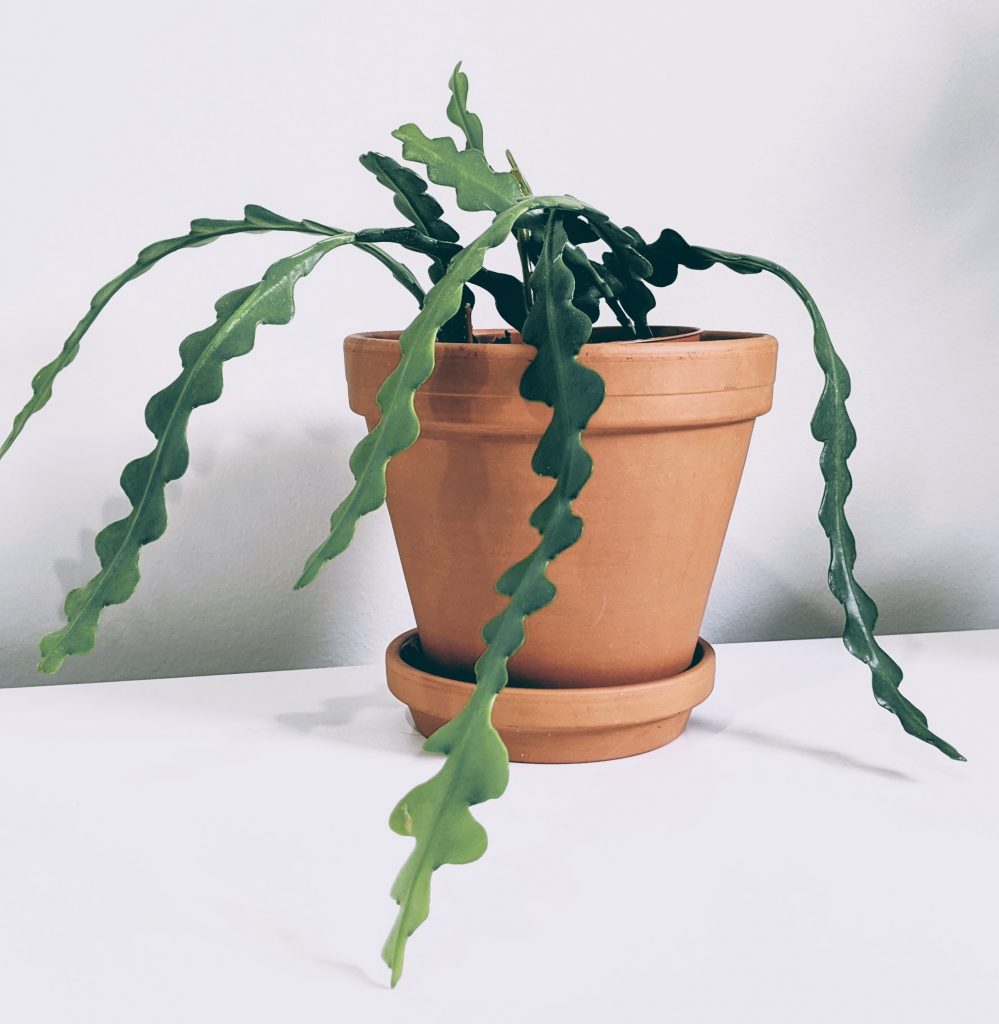If you just brought home a fishbone cactus, you’ve got something very special on your hands – they’re an exotic plant and not easy to find.
For being a somewhat rare plant, fishbone cactus care is relatively low maintenance and perfect for beginner plant parents. In bright, indirect sunlight and a light watering once every 7-10 days, your cactus will thrive.
Identifiable by its long and scaly-looking foliage, the fishbone cactus is also commonly called a zig zag cactus and sometimes referred to as a ric rac cactus – but don’t worry, they’re all the same plant.
Its scientific name is the Disocactus anguliger (formerly Epiphyllum anguliger).
It almost looks closer to a traditional succulent, as the foliage is quite smooth and appears to be void of those quintessential cactus spines or prickles.
Do be careful when handling it though, as sharp spots are still present.
The fishbone originates from the Mexican rainforest, so it prefers a little more water and humidity than your typical arid or desert loving cactus.
This also means that it will grow a little faster, too.
The fishbone cactus is non-toxic to pets, so a perfect option if you’ve got cats, dogs and little kids running around (still, best to not let anyone snack on it just in case).
Even better, since the long stems naturally droop and trail, it makes for a perfect hanging plant.

This post contains affiliate links, which means I may make a small commission if you click through and make a purchase.
How Often to Water Your Fishbone Cactus
Remember that this plant originates from the rainforest, so it likes a little more water than your average desert cactus.
However, don’t keep the soil moist – you want it to dry out slightly in between watering, and less in the winter.
The best way to tell when your fishbone cactus needs water is when it’s dry about one inch below the top of the soil.
In the spring, summer and early fall (peak growing season), it will probably need water every 7 to 10 days.
In the winter, water your zig zag cactus much less frequently. Make sure it’s pretty much completely dried out before watering again.
A quick and easy way to tell when it’s dried out is by picking up the pot- if it feels light and airy, it’s time for more water.
The fishbone cactus also likes a little humidity, so lightly spritz it with a mister every few days, place it on a humidity tray or even keep it in the bathroom.
Pro tip – leaving on vacation for a week or two? Place your fishbone cactus beside an orchid (or other tropical plants) to create a humidity buddy system.

Fishbone Cactus Sunlight Requirements
Bright and indirect sunlight is what’s going to keep your fishbone cactus happy and healthy.
Bright morning sun in a north or east facing window is perfect.
If it’s not getting enough sun, it will start to stretch out and grow long and skinny as it reaches for more light.
Don’t place it in front of full sun or a hot window as your cactus will scorch. Too much sun will stress the plant out and the tips will start to turn darker orange or red.
A simple fix is to move it to a different area in the house where it’s further from the light source.
If your only option is to place it in front of a sunny window, you could keep a sheer curtain closed and that should be enough to provide diffused light.
This plant’s original growing conditions were in the subtropical rainforest bed, growing in the shadows of the trees and dense foliage that surrounds it.
Now, this doesn’t mean the fishbone cactus will survive in low light, but it means it’s a little more tolerant.
Keeping Your Fishbone Cactus Healthy
Plant your cactus in a pot that has a drainage hole, ideally with a saucer on the bottom to catch excess water.
Terracotta or clay pots are the best, since they also pull out excess water. Try to stay away from glazed or coated pots, which won’t allow water to escape as easily.

Read more about choosing the best pot for your succulents and cacti.
Use well draining soil that includes a mix of perlite or peat moss to keep it nice and airy.
Fertilize in the spring through early fall which is the growing season.
I’ve had the best success with Schultz Liquid Plant Food. Dilute a few drops of water in your quart-sized watering can.
In the growing season, I fertilize every second watering. If you forget, don’t worry – sometimes I’ve gone 2 months without fertilizing my indoor cacti and they do just fine.
Hold off on fertilizing in the winter.
New growth on your fishbone cactus will be long and skinny and will take some time before it grows into the zig zag shape – so don’t change a thing!

Pruning and Propagating
If your cactus is getting quite long and scraggly, you can prune it to encourage it to grow more full and dense.
Cut back stems in the spring or summer when it’s growing.
Make sure your sheers are clean and sterilized, and regrowth usually happens anywhere you made a cut.
Then, with your fishbone cactus cuttings, you can propagate them and grow more beloved plants.
Lay them flat on a piece of paper towel and let the cut sides dry out an callus over for a few days.
Once the cut ends look dry and start to form calluses, place them in soil and then leave them alone!
Don’t water your new cuttings until you see signs of growth (bright green spots) – this means it has started to develop roots.
It’s a good idea to regularly prune your fishbone cactus (once a year) to encourage new growth.
How to Get Your Fishbone Cactus to Bloom

It’s not a guarantee that your fishbone cactus will bloom, but I think that’s what makes it fun to own one of these.
I’ve had mine for a couple years and it still hasn’t bloomed – but patience is a virtue when you’re a cactus parent.
If you do manage to produce the elusive bloom, it will likely be light pink with pointed petals. Almost like a passionflower. And the fragrance is so pretty smelling.
But, if you think it’s starting to bloom, don’t take your eyes off of it! It will bloom at night and will only last for a day or two.
If your fishbone cactus does bloom, it will be in late summer or the fall, at the end of the growing season and before it goes into its dormancy or resting phase for the winter.
When to Repot Your Fishbone Cactus
There are a few instances where you’ll want to repot your fishbone cactus. The first is when it outgrows the pot it’s currently living in.
If you haven’t kept up with pruning, then it’s a good idea to move it to a larger pot.
Even if it hasn’t outgrown its current pot, you’ll want to repot it every 2 to 3 years, because after that amount of time the cactus will have used up most of the nutrients in the soil.
If you don’t want to move it to a new pot, you can also just change out the soil for a fresh mix.
Finally, after your fishbone cactus blooms, it’s a good idea to repot it (or at least change out the soil).
Blooming uses up a lot of nutrients, so repot in early spring after a fall bloom.
No matter what your reasoning for repotting, avoid watering for a few days. This lets the roots get situated in the soil before becoming soggy.

Common Problems With the Fishbone Cactus
Some common issues with your fishbone cactus will be yellow tips, leaves or stems.
This means they’re getting too much water. If it’s a little soft and mushy feeling, that’s a sure sign that it’s been too wet for too long.
It can still be saved at this point by leaving it alone until it has completely dried out.
It might help to move it to a location that’s a bit sunnier to help it along.
If your fishbone cactus looks wrinkled, it needs more water and a little more humidity. After giving it a good drink it should perk up and fill out again.
Another sign of underwatering is that the leaves began to slightly curl.
You might also notice the fishbone cactus’ aerial roots start to show. Since it’s an epiphytic plant, the aerial roots can actually grow above the soil.
Sometimes this is just for added support, (like something to cling onto), or sometimes it’s because it needs more humidity.
It could also mean that it’s reaching toward the light (as it would have done in nature).
If you notice woody growth at the bottom of your plant, it’s not a problem. This is just mature growth and nothing to worry about.
Where to Buy a Fishbone Cactus
While I purchased mine at my local greenhouse, they’re not a common plant that local stores regularly carry. You might have some luck online.
There are some sellers of live plants on Etsy. And if you can’t find any plants, you can always order seeds!
Whether you call it a ric rac, zig zag or a fishbone, this cactus will place you at the top of the envy list of your plant-growing friends.
Occasional water, bright indirect light and some love will keep this guy happy and keep you smiling.
Stay Green!



I don’t know if I have fungal or scale on my fishbone. Can I send in a photo? I’ve searched everywhere for an answer.
Hi Brie, sure you can email me aly @ pottedpixie .com (no spaces)